List of olive cultivars facts for kids
Did you know there are hundreds of different types of olives? These special types are called cultivars. The olive tree (Olea europaea) is one of the oldest and most important plants grown by people. Over time, olive trees have changed naturally and with human help, creating many unique varieties.
Olive cultivars are often named after the place they first came from. For example, an olive from Spain might have a Spanish name. Also, olives are usually grown for two main reasons: to make olive oil or to be eaten as table olives. Some types are even good for both!
Discovering Olive Varieties
Here's a look at some of the many interesting olive varieties from around the world.
| Name | Image | Origin | What makes it special |
|---|---|---|---|
| Aglandau |  |
France, Australia, Azerbaijan and Ukraine | This olive is also known as Beruguette when it's eaten as a table olive. |
| Aloreña | Spain | This olive is grown mainly in the Valle del Guadalhorce area of Spain. It's shaped like an egg and sometimes called the "mini apple" because of its shape and color. | |
| Amfissa | Greece | Also called Amphissis, this is a popular Greek table olive. It grows near the ancient oracle of Delphi in Amfissa. These olives are protected by a special status, and they are also good for making olive oil. | |
| Arbequina |  |
Spain | This is a small, brown olive from Arbeca, Spain. It's great for both eating and making oil. |
| Arbosana | Spain | A Spanish olive often grown for oil, similar to Arbequina. It's also grown in places like the United States. | |
| Ascolano | 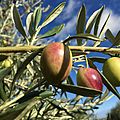 |
Italy | This olive comes from Italy and can handle cold weather well. It's a popular table olive. When it's very ripe and made into oil, it can taste super fruity, like tropical fruit or peaches! |
| Ayvalık | Turkey | Also known as Edremit, this olive is mostly used for making oil. Its name comes from the Turkish cities of Ayvalık and Edremit. | |
| Azeradj | Algeria | When harvested early in November, this olive makes excellent extra-virgin olive oil. | |
| Barnea |  |
Israel | This is a newer type of olive created in Israel. It's good for both eating and oil. It was made to be strong against diseases and to produce a lot of olives. The oil has a strong taste, a bit like green leaves. |
| Beldi | Morocco | These olives are cured (soaked) in oil. They become dark brown or black and look wrinkled after curing. | |
| Biancolilla | Southern Italy, primarily Sicily | This is one of the oldest and most common olives grown in Sicily. It's mostly used for oil. Its name comes from how it changes color from light green to a deep wine color when it's ripe. | |
| Bidni |  |
Malta | This olive is native to Malta and is strong against diseases. It's famous for its great oil and its beautiful dark violet color when ripe. |
| Bosana |  |
Italy | This is the most common olive grown on the island of Sardinia in Italy. It's mostly used for making oil. |
| Bouteillan | France | An olive type grown in France for making olive oil. | |
| Cailletier (Taggiasca) |  |
France, Italy | Grown mainly in the Nice area of France and nearby Italy, where it's called Taggiasca. When prepared for salads, it's known as Niçoise olives. |
| Calabria |  |
Southern Italy | These olives are grown in the Calabria region of Italy. Some of these olive trees can grow very large, with trunks up to sixteen feet around! |
| Carolea | Italy | An olive oil variety grown mostly in the Basilicata and Calabria regions of Italy. | |
| Cerasuola | Southern Italy, primarily Sicily | This olive is common in Sicily and is used for oil. It gives a lot of oil and can handle dry weather well, which is important in Sicily. | |
| Cerignola |  |
Italy | These very large olives come from southern Italy. They have a mild taste and can be green, red, or black when served. |
| Chemlali | Tunisia | A type of olive grown in Tunisia. | |
| Chetoui | Tunisia | Another olive variety from Tunisia. | |
| Cobrançosa | Portugal | A variety of olive grown in Portugal. | |
| Conservolea | Greece | A very important table olive in Greece, similar to the Amfissa olive. | |
| Coratina |  , ,  |
Italy, Croatia | This is one of the most important Italian olive types, especially in Puglia, Italy's biggest olive-growing area. It makes a strong-tasting olive oil. |
| Cornicabra | Spain | This olive comes from Toledo, Spain. It's mainly used for oil and makes up about 12% of Spain's olive production. It's also the main olive used for oil in Algeria. | |
| Domat | Turkey | A common Turkish green olive, used both as a table olive and for oil. | |
| Dritta | Italy | This olive tree is special to the Pescara area of Italy. Its olives make an extra virgin olive oil with amazing qualities. | |
| Empeltre |  |
Spain | A medium-sized black olive grown in Spain, especially in the Ebro Valley. It can be used for both eating and oil, but mostly for oil. |
| Frantoio |  |
Italy | This olive, along with Leccino, is a main ingredient for Italian olive oils from Tuscany. Frantoio oil is fruity and has a stronger taste than Leccino. |
| Galega | Portugal | Also known as Galega Vulgar, this is a variety grown in Portugal. | |
| Gemlik | Turkey | This olive comes from the Gemlik area of Turkey. These small to medium-sized black olives have a lot of oil. They are very common in Turkey and are often eaten for breakfast. | |
| Gentile di Chieti | Italy | An Italian olive variety typical of the Abruzzo region. | |
| Germaine | Corsica, Italy | This olive is good for both eating and oil. It can handle cold weather and turns black when ripe. | |
| Gordal (Queen olive) | Seville and Andalusia, Spain | This is a table olive. Its name means "the fat one" because of how big it is. | |
| Halkidiki | Greece | Very large table olives from the Halkidiki region of Greece. They are also called gaidouria, which means donkey olives. | |
| Hojiblanca |  |
Spain | This olive comes from Lucena in Spain. Its oil is popular for its slightly bitter taste. |
| Hondroelia | Greece | This is a rare olive from Astros. It's blond and traditionally cured in salt. | |
| İzmir Sofralık | Turkey | A Turkish olive mostly grown for olive oil. | |
| Kalamata |  |
Greece | A large, black olive with a smooth, meaty taste. It's named after the city of Kalamata, Greece, and is used as a table olive. These olives are often kept in wine, vinegar, or olive oil. |
| Koroneiki | 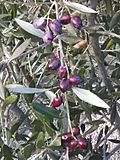 |
Greece and other areas | This small olive comes from the southern Peloponnese area of Greece. Even though it can be tricky to grow, it produces a lot of excellent olive oil. |
| Kothreiki | Greece | This olive is good for both oil and as a table olive. | |
| Lechín de Sevilla | Spain | This is an important olive in Andalusia, Spain. Its oil has a fruity taste with hints of green, a little bitter, and a smooth feel. | |
| Leccino | 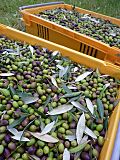 |
Italy | Like Frantoio olives, Leccino olives are a main ingredient for Italian olive oils from Tuscany. Leccino oil has a mild, sweet taste. |
| Lucques |  |
France | Found in the south of France. These olives are green, large, and long. They have a mild, nutty flavor. |
| Maalot | Israel | This olive was developed in Israel and is strong against diseases. It's a medium-sized, round olive with a fruity taste, used almost only for oil. | |
| Manzanilla | 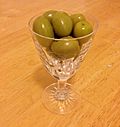 |
Spain | A large, rounded-oval olive with purple-green skin, from Seville, Spain. "Manzanillas" means "little apples" in Spanish. It's known for its rich taste and thick flesh and is grown all over the world. |
| Mastoidis | Greece | A Greek table olive similar to Tsounati. | |
| Memecik | Turkey | This is the main olive type in the Aydin Province of Turkey. | |
| Meslalla | Morocco | A Moroccan green olive used for olive oil. It's also pickled with garlic and hot peppers and used in traditional dishes like tagines. | |
| Mission | 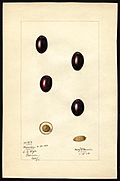 |
United States | This olive started in the California Missions and is now grown all over the state. They are black and usually eaten as table olives. |
| Morrut | Spain | Grown in the Tarragona area of Spain. The fruit tastes spicy and a little bitter, with flavors of almond and green apple. | |
| Nabali | Israel | This olive comes from Israel and is known locally as Baladi. It's also widely used in Jordan and Syria. | |
| Nafplion | Greece | A small green olive grown only in the Argos valley in Greece. Nafplion olives are traditionally cracked and cured in salty water. | |
| Nocellara del Belice |  |
Italy | A large green olive grown mainly in Sicily. In the United States, they are also called Castelvetrano olives. They have a mild, buttery taste, making them popular table olives, but they are also used for oil. |
| Nyons |  |
South of France | This was the first olive in France to get a special quality label in 1994. To be called Nyons Olives, they must be of the Tanche variety and grown in a specific area. |
| Picholine | 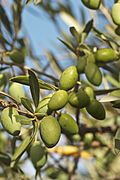 |
France | Grown in the south of France. It's green, medium-sized, and long. The flavor is mild and nutty. |
| Picual | 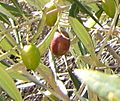 |
Spain | From southern Spain, this is the most widely grown olive in Spain. It makes up about 50% of Spain's olive production and around 20% of all olives grown worldwide! It has a strong but sweet flavor and is often eaten as a table olive in Spain. |
| Ravece | Italy | This olive has a special quality label. | |
| Salkini | Syria, Lebanon, Jordania | An olive variety found in these Middle Eastern countries. | |
| Sevillano | Spain, California | This olive has many different names depending on where it's grown. | |
| Sevillenca | Spain | This olive is grown in Spain and has a special protected status in some areas. It's exported to many countries in Europe. | |
| Chiquitta | Spain | A type of olive from Spain. | |
| Souri | Lebanon | Named after the town of Sur (Tyre), this olive is mainly grown in Southern Lebanon and Northern Israel. It gives a lot of oil and has a wonderfully fragrant flavor. | |
| Swan Hill Olives® | Australia | This olive is often grown as a decorative tree because it produces almost no pollen that causes allergies and doesn't drop much fruit. | |
| Tanche |  |
France | This black olive can be used for both eating and making oil. |
| Thassos |  |
Greece | This is the only olive type that can be eaten right off the tree when it's ripe! |
| Throumbolia | Greece | This olive is good for both oil and as a table olive. | |
| Tsounati | Greece | See Mastoidis. | |
| Verdial | Spain | A type of olive from Spain. |
See also
- Lists of cultivars

All content from Kiddle encyclopedia articles (including the article images and facts) can be freely used under Attribution-ShareAlike license, unless stated otherwise. Cite this article:
List of olive cultivars Facts for Kids. Kiddle Encyclopedia.

